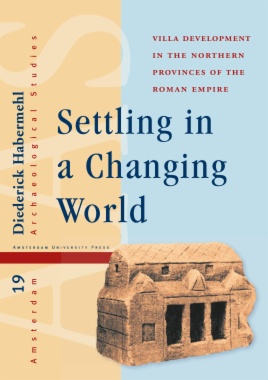Offering a broad analysis of the complex developments in rural habitation of the northern provinces of the Roman Empire, Settling in a Changing World reconstructs the colonial villa from social and economic perspectives to create a broad geographical and chronological framework that sheds light on both local and regional patterns. Considering data from the Netherlands, Belgium, Germany, and France, Diederick Habermehl analyzes, visualizes, and reconstructs the developments in settlement space and architecture. Applying theoretical concepts from both archaeology and cultural studies, this groundbreaking book ultimately offers a new perspective on the Roman villa as an architectural and cultural phenomenon.
- Contents
- Preface
- I. Introduction
- 1.1 General
- 1.2 Geographical and chronological framework
- 1.3 View on villa and settlement
- 1.4 An interpretative framework
- 1.5 Structure of this study
- 2. Data and Research
- 2.1 Constructing a dataset
- 2.2 Basic characteristics: size and distribution
- 2.3 The research background
- 2.4 Representativity and biases
- 2.5 Questioning the dataset: house architecture, settlement layout, and regional differentiation
- 3. Exploring Villa Development
- 3.1 Changing perspectives on villa development
- 3.2 Exploring settlement development trajectories
- 3.3 Developments in house building: exploring architectural change
- 3.4 Villa development between continuity and change
- 4. Exploring the Social Villa. A Human Approach to Villa Deveopment
- 4.1 The social study of villas
- 4.2 Variation in settlement scale
- 4.3 The reorganisation of space: constructing new social realities
- 4.4 Breaking with the old and building the new: social strategies in a changing world
- 4.5 Local and regional heterogeneity and the nature of asymmetrical social relationships within settlements
- 4.6 Some concluding thoughts
- 5. Villa Developments and the Organisation of Production
- 5.1 The wider context of economic developments in the countryside
- 5.2 Market orientation and developments in agrarian production
- 5.3 Exploring the spatial architectural and social dimensions of production
- 5.4 Regional differentiation: nunancing the 'villa mode of production'
- 6. Settling in a Changing World: A Synthesis
- 6.1 Reconstructing development trajectories
- 6.2 Interpreting development trajectories from a multi-dimensional approach
- 6.3 Interpreting villa development as a process of change: 'becoming Roman'?
- 6.4 Avenues for future research
- References
- Appendix I. Site Catalogue

